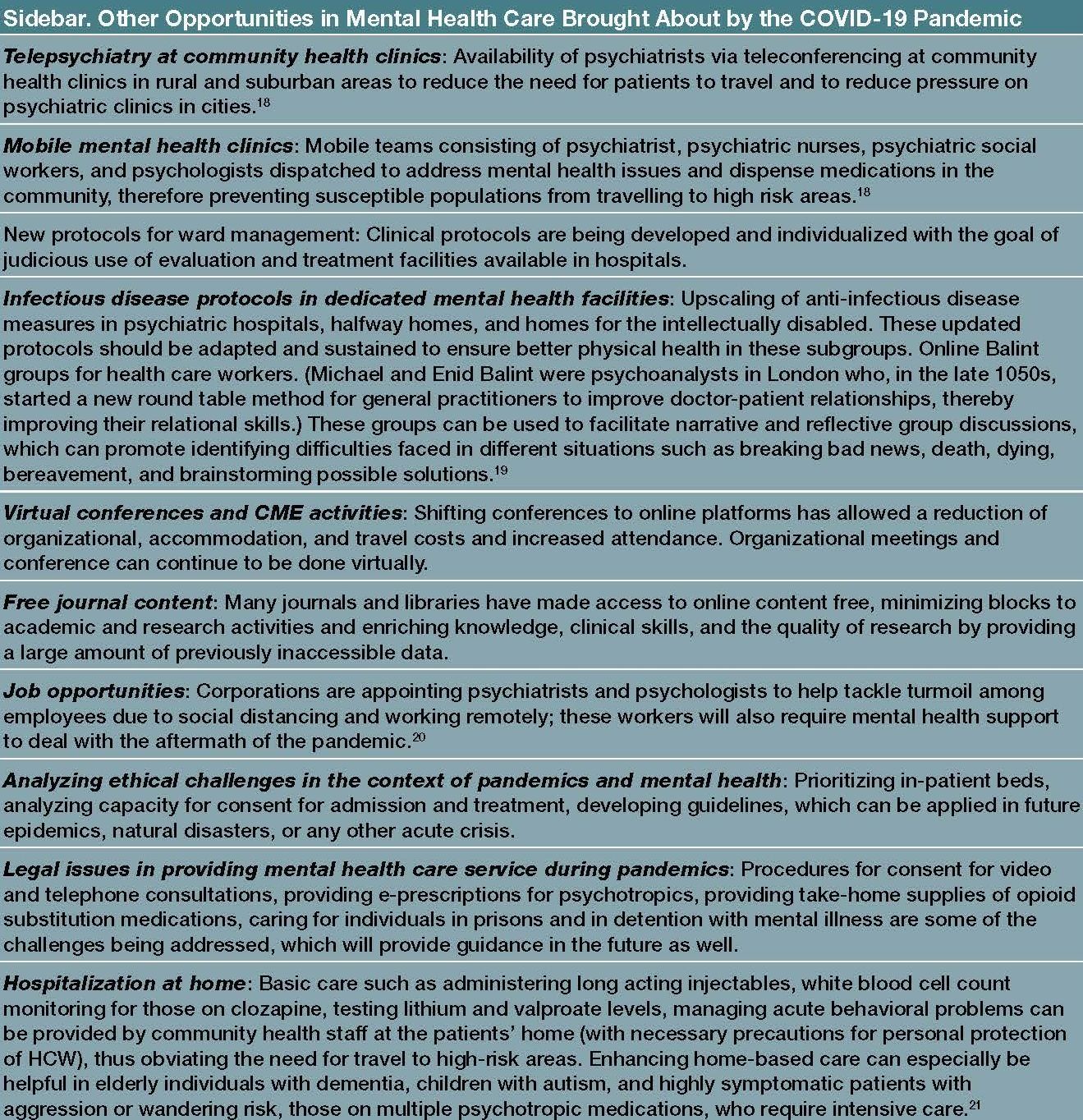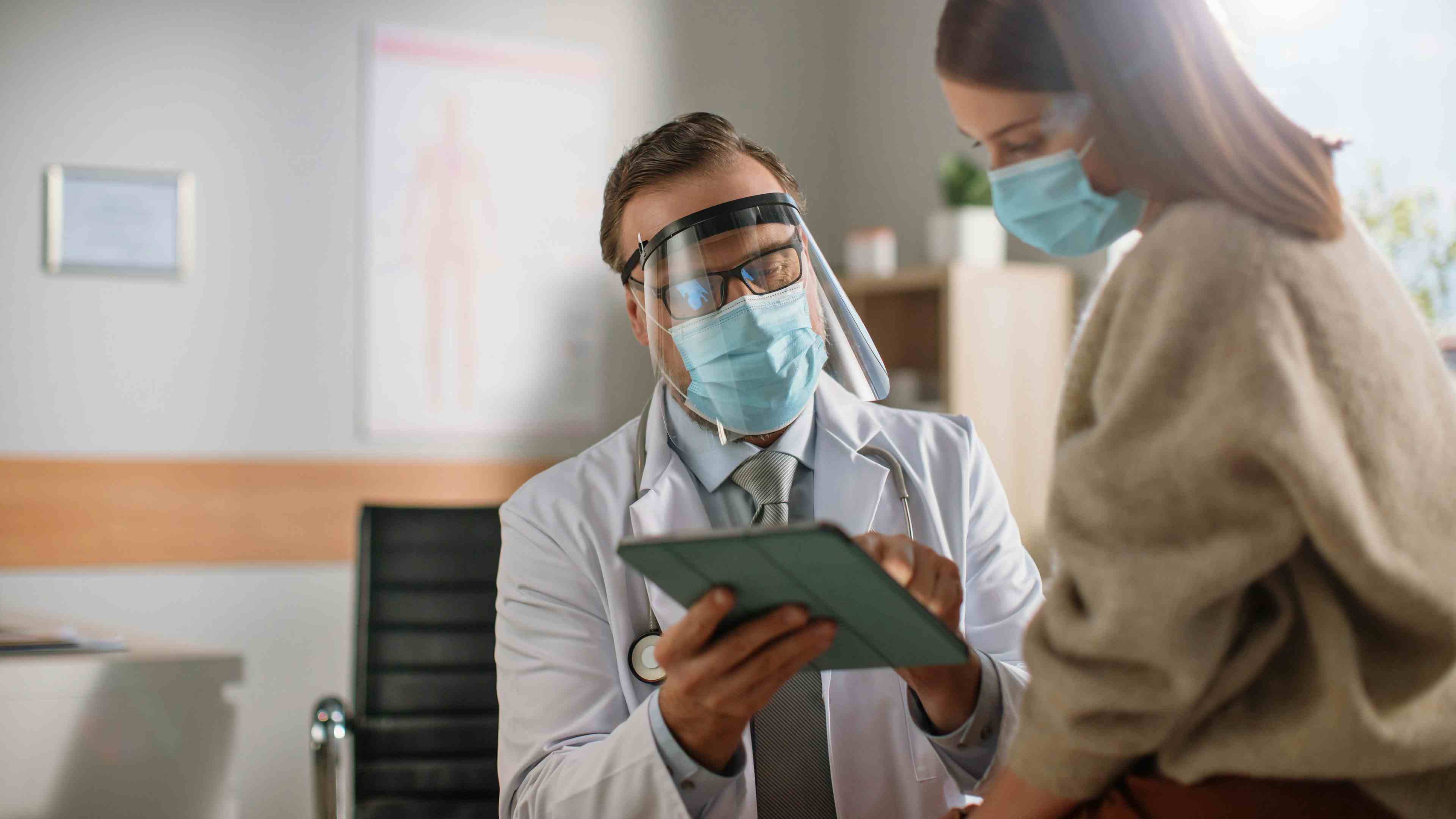Article
Necessity Is Often the Mother of Innovation: Lessons for Psychiatry From COVID-19
Author(s):
Amidst the fear, worry, and uncertainty surrounding the coronavirus pandemic, each day seems to bring news that is worse than the day before.

Sidebar: Other Opportunities in Mental Health Care

Amidst the fear, worry, and uncertainty surrounding the coronavirus pandemic, each day seems to bring news that is worse than the day before. The cause for concern is justified. The COVID-19 pandemic has caused devastating physical, psychological, social, and financial repercussions at individual as well as community levels. This can lead to adverse emotional and behavioral outcomes such as depression, anxiety, and increased substance use.
The Spanish Influenza of 1918, the 2009 H1N1 outbreak, and the Ebolavirus in 2014 have all been noted to be associated with an increase in depression, anxiety, stigma, and shaming.1 It is worth noting that these terrible events have also led to exceptional transformations in mental health care. The COVID crisis has forced us to deeply consider the use of creative solutions to deal with the mental health fallout of the pandemic.
With this background, we aim to highlight the positives that psychiatry needs to take away from this pandemic and possibly consolidate in the decade ahead. It is important to recognize the silver linings and identify changes that may have had a significant positive impact on mental health and potentially transforming psychiatry as a clinical field. This article is based on our perspectives, our experiences during the pandemic, and the mental health consequences in Asia, notably India. Nevertheless, this is a global pandemic, informed decisions and innovations in one country can easily be adapted and implemented in other countries.
Treatment related changesTelepsychiatry. With social distancing and the lockdown that restricts travel, routine in-person consultations become almost impossible for patients. This move has been a paradigm shift in traditional clinical practice, where in-person consultations hold an almost sacrosanct place in the doctor-patient relationship. Telepsychiatry has opened newer avenues for both patients and doctors. It took a crisis like COVID to get several mental health systems to overcome the passivity of utilizing this method.
Structured letter therapy. A form of remote written counselling that may become a new type of psychological counselling mode in the context of public health emergencies. It consists of a patient page with socio-demographic information, questions about emotional difficulties, and a section for the patient’s queries. The intervention page consists of providing patients possible reasons for the current distress, how to ease the distress, content of the interview, and possible diagnosis, if applicable. Self-rating scales according to the psychological problem are also available to the patient.2 Taken forward, even after the end of the pandemic, these and similar interventions can play a unique role in reducing costs and benefit individuals who may not be able to access in-person consultations.
Home delivery of psychotropic medications. With the current restrictions, mail order or home delivery service have been offered by psychiatrist/pharmacists working in conjunction with social workers, volunteers, care coordinators, and neighborhood welfare organizations. This method of procuring medications remotely has been publicized through notifications on the internet, text messages, emails. Pharmacies have also been sharing information about drug availabilities and their store locations online or through mobile applications to guide patients.3
The use of E-prescriptions has increased and has reduced wait times for patients since it is no longer necessary to manually enter the prescription details into the database at the pharmacy. Pharmacies are also able to use the E-prescriptions to better regulate and track the number and dosage of psychiatric medications dispensed to each patient. This could improve patient safety by preventing complications such as drug overdose and drug abuse. It is likely that more pharmacies and hospitals will look to implement these measures beyond this pandemic.
Hospital helplines. The current pandemic has set in motion the development of institutional, departmental, and emergency helplines for patients. These helplines cater to various needs of the callers, such as stress due to the pandemic, anxiety, depression, queries related to health, medications, and so on.4 These can be continued even after this crisis ends and can offer a great advantage in providing immediate aid to patients and families in distress. For some others, it could be a less stigmatizing way of seeking help. Just the knowledge that such an option exists could be very reassuring for many patients with mental health problems.
Interventions related to supportOnline caregiver support. Caregiver support is an important aspect of management and can often get neglected at the best of times, let alone during an infinitely more difficult situation, where caregivers may not be able to avail themselves of the necessary support such as domestic help and other formal services. In a traditional scenario, based on where a person is living, they may not be able to find a strong caregiver support group in their city, or they may only have access to a small group.5
Online caregiving support groups are not limited by geography or by a small number. Members can join from anywhere, which provides the potential to find a larger number of people who can connect. Traditional support groups will meet at a consistent time, probably only once a week, but online groups can connect at any time. If a session is missed, a recording could be made available. Caregivers looking after children with neurodevelopmental disorders and elderly suffering from dementia might find the online platform especially useful.
Digital mental health. With many centers for mental health interventions such as medical colleges, private psychiatric clinics, and clinical psychology offices closed, notable digital alternatives have been brought into play. Popular meditation apps such as Calm.com and Headspace have released free digital offerings to help the public cope with anxiety and panic. Apps that can be used to maintain mood charts, those that provide confidential text messaging, and text hotlines for workplace issues have all seen increased use.6
Looking ahead, it is going to be important to teach clinicians how to use digital and mobile technologies for delivering care. Certain patient groups will also need support from mental health professionals to enhance digital literacy and competencies. Frameworks for competencies already exist, and some have already been implemented.4 This is an opportunity to consider how best to streamline these services. They will need funding, research, policy changes, training, surveillance, and most importantly, an open-minded approach coupled with essential imagination from the global psychiatry collective.
Academics, capacity building, and researchInnovations in research and developing research methods rapidly. Researchers have had the opportunity to gain new insight, bond more closely with their colleagues, and create new collaborations. Moreover, they have had the one thing that researchers never have enough time for: time to think. While most researchers are skilled at thinking of novel ways to look at problems, the pandemic is challenging the ability of even the most cognitively capable to plan, focus, and re-innovate. This can only bode well for the future.
Virtual learning. Teaching and learning have also been significantly affected by the COVID crisis. Medical schools are providing online classes through Zoom, Skype, Microsoft Teams, and other platforms. This move has multiple advantages, in the form of continued and uninterrupted curricular activities, the option of recording classes, and on-the-go access as clinical duties and emergencies may prevent all students from attending the lectures at the designated time. The prevailing situation has also provided an opportunity to integrate innovative teaching strategies into regular curricular activities, such as online polls and quizzes, educational games, podcasts, and so on.
Using an online method of examinations/assessments has also been considered to ensure that the academic progress of medical students and psychiatry residents is not disrupted. This method needs to be compared longitudinally with the traditional written/face-to-face examinations to ascertain how it can supplement standardized exams beyond the pandemic. Virtual learning should be rebooted, if its training is to be mandatory for medical students and residents, academic faculty need to be better trained in all e-learning tools. In the coming decade, for educators, use of technology could be the rule rather than the exception.
Practical exposure for psychiatry residents. The pandemic can be seen as an opportunity to directly observe the consequences of rare phenomena and how their impact of psychopathology and presentations of different psychiatric illnesses. Being a once-in-a-lifetime crisis, akin to natural disasters and war, COVID-19 is leaving its mark on everyone, especially so on individuals with psychiatric illness. The period has seen the emergence of new presentations and phenomenology, insistence on hygiene, and fear about illness coloring the psychopathology in distinct ways. Along with the expected spate of contamination obsessions and washing compulsions, depression, anxiety, loneliness, and psychotic symptoms incorporating the present situation in various ways have come to light.7 This provides a unique learning opportunity that can be used through observation and discussion with peers and faculty. Psychiatry resident organizations and training groups should also take the initiative to ensure residents are exposed to telepsychiatry, considering the dominant role this modality could have in the future.
Innovative therapy and rehab modules. Therapists have modified their approaches significantly by embracing teletherapy, video and telephone sessions, utilizing family members as co-therapists, and incorporating innovative behavioral techniques that do not require leaving the house.4,8 Computer or internet-based cognitive behavioral therapy (CBT), which provides the user with an interactive app or website-based sessions are also gaining popularity as potential solutions to the current problem.9
Several centers across the globe have also expanded teletherapy services to embrace online speech and occupational therapy for children with a variety of neurodevelopmental disorders, especially autism. The initial response from both parent and children to this measure seems to be encouraging and we need to consider if we can settle on an amalgam of online and offline solutions for these families in the future.
Mental health education has been delivered to medical staff, students, the general population, and patients with COVID-19 infection through platforms such as WeChat, Weibo, and TikTok. WeChat-based online counselling services such as CBT for depression, anxiety, and insomnia, and even artificial intelligence recognition of individuals at risk for suicide, have been conducted in China with positive outcomes.4 Going forward, some of these can be undertaken as self-help or with remote guidance, which is affordable and can be done from the comfort of one’s home.
Psychiatric training in general medicine and emergency medicine (initiative at St John’s Medical College, Bangalore). Psychiatry residents and faculty alike are being given hands-on training in general and emergency medicine, via revision and reskilling programs conducted by various departments in the hospital. These include emergency procedures such as cardiopulmonary resuscitation, endotracheal intubation, assessing and identifying red-flag signs of common illnesses, and basic management protocols in each. This is something that will remain relevant during the clinician’s entire career. Short reskilling programs that focus on evaluation and management of common cases in the outpatient and emergency setup can be conducted annually for students and faculty. These would help maintain familiarity towards other specialties and remind clinicians to manage patients as a whole rather than the fragmented care which is the norm in present practice.
Training non-psychiatrists on emergency psychiatry care (initiative at St John’s Medical College, Bangalore). As the crisis worsens, there has been an unprecedented increase in manpower needs. Keeping in mind the very real possibility of a further increase in the number of suspected or positive COVID cases, it has become necessary for a few hospitals to recruit doctors from the pre- and para-clinical departments to work on the frontlines. During the course of these clinical duties, clinicians may come across patients with psychiatric illnesses, which needs to be addressed.
Psychiatry is one of the specialties for which there is minimal exposure and training during MBBS and internship, and therefore, it is necessary to get an overview in order to address potential clinical situations. With this, psychiatry teams have been able to train the pre- and para-clinical faculty on psychiatric emergencies, which is a practice that can be continued to great advantage, even beyond the pandemic.
Scaling up psychiatric nursing (initiative at St John’s Medical College, Bangalore). Nursing staff are the first point of contact for patients and caregivers in all hospital settings, and often spend the largest amount of time with patients throughout their hospital stay. This places psychiatric nurses in a unique position-they are the first to assess patients and the earliest to identify signs of distress, which therefore lead to early interventions. In many centers psychiatric nurses have been trained to screen patients in the COVID isolation wards using a tele-conferencing method. On duty nurses have been provided with a screening checklist for evaluation of mental health problems. Such methods could be adopted for the long-term in the intensive care units and emergency departments.
Being trained in counselling skills, psychiatric nurses can be earmarked as peer mentors for other staff working on the frontlines. They could address the stress health care workers experience due to the high workload, frequent shift changes, inadequate sleep and rest, and the fear of getting infected or infecting others, which can lead to fatigue, discomfort, helplessness, and anxiety.10
A stepped care approach. Stepped care, the practice of delivering the most efficient, least resource-heavy treatment to patients, and then transitioning to more resource-heavy treatment based on patients’ needs, is a pragmatic approach in mental health.11 This will require that systems are well designed and clinicians are well prepared to deliver this care to patients-from screening to the overflow of mental illness that could inevitably emerge from this pandemic.
Organizations could consider training community health workers and primary care physicians to provide psychological first aid and help teach the general public to check in with one another and provide support. Telemedicine mental health visits, group visits, and delivery of care via technology platforms will be important components of stepped care for both acute crisis management and more routine mental health care.11
Redefining the role of medical students and changes in undergraduate curriculum. Medical students have come up with innovative ways of contributing to this war against COVID-19. Many have made educational videos, posters, audio clips, infographics, pamphlets, and other material to be shared via social media. Some have organized virtual entertainment events to provide much-needed relaxation to frontline workers. In some cases, medical students have formed national networks to brainstorm ideas, taken basic training from faculty, and volunteered in manning hospital helplines, triaging patients over the phone and dispensing medicines in clinics.12 Until now they have been confined to classrooms in college and discussion rooms in the ward during clinical rotations. However, they are a creative force to reckon with, and can be trained in basic clinical work when there is a grave shortage of manpower and patient in-flow is ever increasing.
Medical undergraduate curricula would now have to offer insights into the pandemic including the psychological distress, the impact on vulnerable groups such as the elderly, children, health care workers, migrant workers, pregnant women ,and those with pre-existing mental and medical conditions. Considering that the mental health consequences of the pandemic will be present for many years, this will prepare them to address the issues as future doctors. It might also encourage them to choose psychiatry as a career.13
Interventions related to special populationVulnerable groups. The most vulnerable groups during the pandemic will continue to be the most vulnerable groups beyond the pandemic. Migrants and the homeless mentally ill are two groups that have been the most affected during this pandemic.14 On one hand, humanitarian aid (including those driven by mental health professionals) providing for basic needs like food, water, clothing, and medications has been immensely significant in reducing distress. One wonders, however, why must this stop after the pandemic? We must also consider the workforce that is likely to have the most contact with these vulnerable groups such as police officers, medical social workers, community case workers, and even primary care physicians. Setting up online consultation liaison modules for these professionals might help with early intervention and in shaping an effective pathway of care to mental health institutions.
Domestic violence and child sexual abuse. A lot of innovative services such as online supports, chatbots, and helplines have been started for domestic violence along with National campaigns with the objective of signposting victims to sources of help. Just having a helpline alone will not suffice, they need to be actively linked to NGO’s that can provide safety and shelter as well as organizations that can help with vocational services. It is imperative that they become a regular service beyond the pandemic.
We have never had a chance to help victims as much as we are going to have now. As a mental health collective we must fight for policies to ensure economic and social support for these women so that they never have to rely on an abusive partner ever again, we need to help them find safer communities and legal aid. In some countries a “safer spaces” scheme has been started to offer confidential help at supermarkets, department stores, malls, pharmacies, and retail shops so that victims can visit without arousing suspicion in abusive partners.15 Innovations due to a pandemic should be implemented with conviction in the future as well.
Mental health of health care professionals. This has come into both public and media focus very prominently, unlike anything before. Online toolkits have been prepared for doctors and nurses, dedicated helplines, chatbots, meditation apps for doctors, and debriefing sessions have become a routine at the end of shifts. Wellness committees’ online lounges and peer support groups have also been formed.16 All of these need to continue. Because of a series of unfortunate events involving violence and stigma towards health care providers (HCPs) that has come to light through social media and other mass media, there has been intense scrutiny of the mental health of HCPs. In response to these incidents, the Government of India has passed an ordinance to tighten the laws against violence towards HCPs.17 However, violence against HCPs has been much too commonplace even before the COVID crisis, and this ordinance should be further taken forward and consolidated to address these concerns in the longer term.
Conclusion
Necessity is the mother of invention. Many revolutionary changes in the field of medicine and of psychiatry have historically occurred at times of severe crisis. Likewise, the ongoing COVID-19 pandemic has, with time, become a lightning rod of interventions and opportunities. Interventions and changes pertinent to treatment such as support for patients, medical education, learning, and research can change the way psychiatry is practiced in the next decade and maybe even longer. For additional resources see Sidebar.
Disclosures:
Dr Chandran is Assistant Professor, Department of Psychiatry, St John’s Medical College Hospital, St John’s National Academy of Health Sciences, Bangalore, Karnataka, India; Dr Kuppili is Assistant Professor, Department of Psychiatry, Sri Venkateshawaraa Medical College Hospital and Research Center, Puducherry, India. The authors report no conflicts of interest concerning the subject matter of this article.
References:
1. Moukaddam N. Fears, outbreaks, and pandemics: lessons learned. Psychiatric Times. November 15, 2019; Epub ahead of print.
2. Xiao C. A Novel approach of consultation on 2019 novel coronavirus (COVID-19)-related psychological and mental problems: structured letter therapy. Psychiatry Invest. 2020;17:175-176.
3. Zheng S, Yang L, Zhou P, et al. Recommendations and guidance for providing pharmaceutical care services during COVID-19 pandemic: a China perspective. Res Soc Adm Pharm. March 26, 2020; Epub.
4. Liu S, Yang L, Zhang C, et al. Online mental health services in China during the COVID-19 outbreak. Lancet Psychiatry. 2020;7:e17-e18.
5. Wang H, Li T, Barbarino P, et al. Dementia care during COVID-19. Lancet. 2020;395:1190-1191.
6. Farley S. Mental health in the time of COVID-19: tech interventions for a growing crisis. Forbes. April 15, 2020.
7. Banerjee DD. The other side of COVID-19: impact on obsessive compulsive disorder (OCD) and hoarding. Psychiatry Res. 2020;288:112966.
8. Duan L, Zhu G. Psychological interventions for people affected by the COVID-19 epidemic. Lancet Psychiatry. 2020;7:300-302.
9. Andersson G, Carlbring P, Ljótsson B, Hedman E. Guided internet-based CBT for common mental disorders. J Contemp Psychother. 2013;43:223-233.
10. Sun N, Shi S, Jiao D, et al. A qualitative study on the psychological experience of caregivers of COVID-19 patients. Am J Infect Control. April 8, 2020; Epub.
11. Galea S, Merchant RM, Lurie N. The mental health consequences of COVID-19 and physical distancing: the need for prevention and early intervention. JAMA Intern Med. April 10, 2020.
12. Murphy B. 5 ways medical students can assist during the COVID-19 pandemic. Am Med Assoc. March 25, 2020; Epub.
13. Buckley MRF. A COVID-19 Curriculum. Harvard. April 14, 2020; Epub.
14. Tsai J, Wilson M. COVID-19: a potential public health problem for homeless populations. Lancet Public Health. 2020;5:e186-e187.
15. Coronavirus lockdown: Boots offers safe space for domestic abuse victims. BBC News. May 1, 2020.
16. Chen Q, Liang M, Li Y, et al. Mental health care for medical staff in China during the COVID-19 outbreak. Lancet Psychiatry. 2020;7:e15-e16.
17. PRS Legislative Research. India’s Response to COVID-19: The Epidemic Diseases (Amendment) Ordinance, 2020. April 22, 2020;Epub.
18. Xiang Y-T, Zhao Y-J, Liu Z-H, et al. The COVID-19 outbreak and psychiatric hospitals in China: managing challenges through mental health service reform. Int J Biol Sci. 2020;16:1741-1744.
19. Balint groups could be one way to prevent burnout during covid-19. BMJ. May 1, 2020; Epub.
20. Dave S. COVID-19: Companies rope in psychiatrists, experts for emotional counselling of work from home employees. Economic Times. March 26, 2020; Epub.
21. Vieta E, Pérez V, Arango C. Psychiatry in the aftermath of COVID-19. Science Direct. April 23, 2020; Epub.















